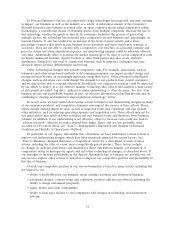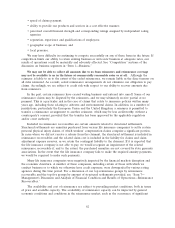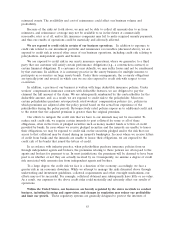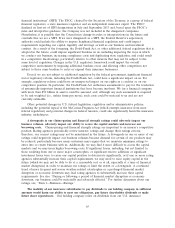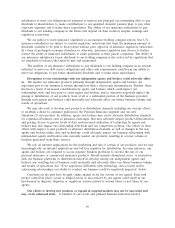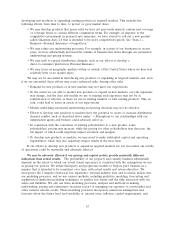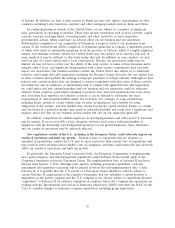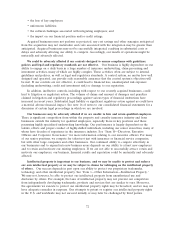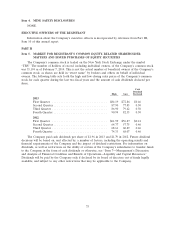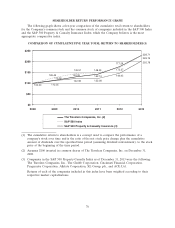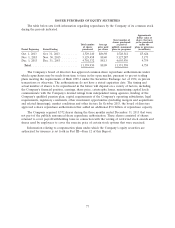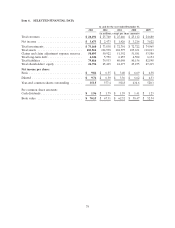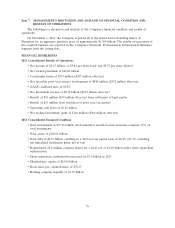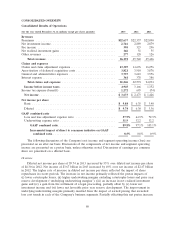Travelers 2013 Annual Report Download - page 81
Download and view the complete annual report
Please find page 81 of the 2013 Travelers annual report below. You can navigate through the pages in the report by either clicking on the pages listed below, or by using the keyword search tool below to find specific information within the annual report.In July 2013, the IAIS published a methodology for identifying ‘‘global systemically important
insurers’’ (G-SIIs) and high level policy measures that will apply to the G-SIIs. The methodology and
measures were endorsed by the Financial Stability Board (FSB) created by the G-20. Using the IAIS
methodology, the FSB, working with national authorities and the IAIS, identified nine insurers that
they designated as G-SIIs. The IAIS is working on the policy measures which include higher capital
requirements and enhanced supervision. The Company was not named a G-SII by the FSB in the initial
designation. The FSB will update the list annually, and it is possible that the methodologies could be
amended or interpreted differently in the future and the Company could be named as a G-SII.
The IAIS also is in the process of developing the Common Framework for the Supervision of
Internationally Active Insurance Groups (Comframe). The IAIS released a Consultation Draft in
October 2013, which may lead to similar policy measures as those being developed for G-SIIs, including
group supervision and an Insurance Capital Standard (i.e., global group capital requirement). The
Company would be considered an Internationally Active Insurance Group under the current
Consultation Draft. It is possible that Comframe could lead to enhanced supervision and higher capital
standards on a global basis if the IAIS, the NAIC and the individual states adopt the proposed or
similar provisions.
While it is not yet known how or if these actions will impact us, such regulation could result in
increased costs of compliance, increased disclosure and less flexibility in our capital management, and
could adversely impact our results of operations and limit our growth.
Loss of or significant restrictions on the use of particular types of underwriting criteria, such as
credit scoring, in the pricing and underwriting of our products could reduce our future profitability.
Our underwriting profitability depends in large part on our ability to competitively price our products
at a level that will adequately compensate us for the risks assumed. As a result, risk selection and
pricing through the application of actuarially sound and segmented underwriting criteria is critical.
However, laws or regulations, or judicial or administrative findings, could significantly curtail the use of
particular types of underwriting criteria. For example, we may use credit scoring as a factor in pricing
decisions where allowed by state law. Some consumer groups and/or regulators have alleged that the
use of credit scoring violates the law by discriminating against persons belonging to a protected class
and are calling for the prohibition or restrictions on the use of credit scoring in underwriting and
pricing. A variety of other underwriting criteria used in personal and commercial insurance have been
and continue to be criticized by regulators, government agencies, consumer groups or individuals on
similar or other grounds. Resulting regulatory actions or litigation could result in negative publicity
and/or generate adverse rules or findings, such as curtailing the use of important underwriting criteria,
each of which could adversely affect our future profitability.
Acquisitions and integration of acquired businesses may result in operating difficulties and other
unintended consequences. From time to time we may investigate and pursue acquisition opportunities
if we believe that such opportunities are consistent with our long-term objectives and that the potential
rewards of an acquisition justify the risks. For example, in November 2013, we acquired Dominion and
significantly expanded our Canadian operations. The process of integrating an acquired company or
business can be complex and costly, however, and may create unforeseen operating difficulties and
expenditures. For example, acquisitions may present significant risks, including:
• the potential disruption of our ongoing business;
• the ineffective integration of, or other difficulties with, underwriting, risk management, claims
handling, information technology and actuarial practices;
• uncertainties related to an acquiree’s reserve estimates and its design and operation of internal
controls over financial reporting;
• the diversion of management time and resources to acquisition integration challenges;
71


